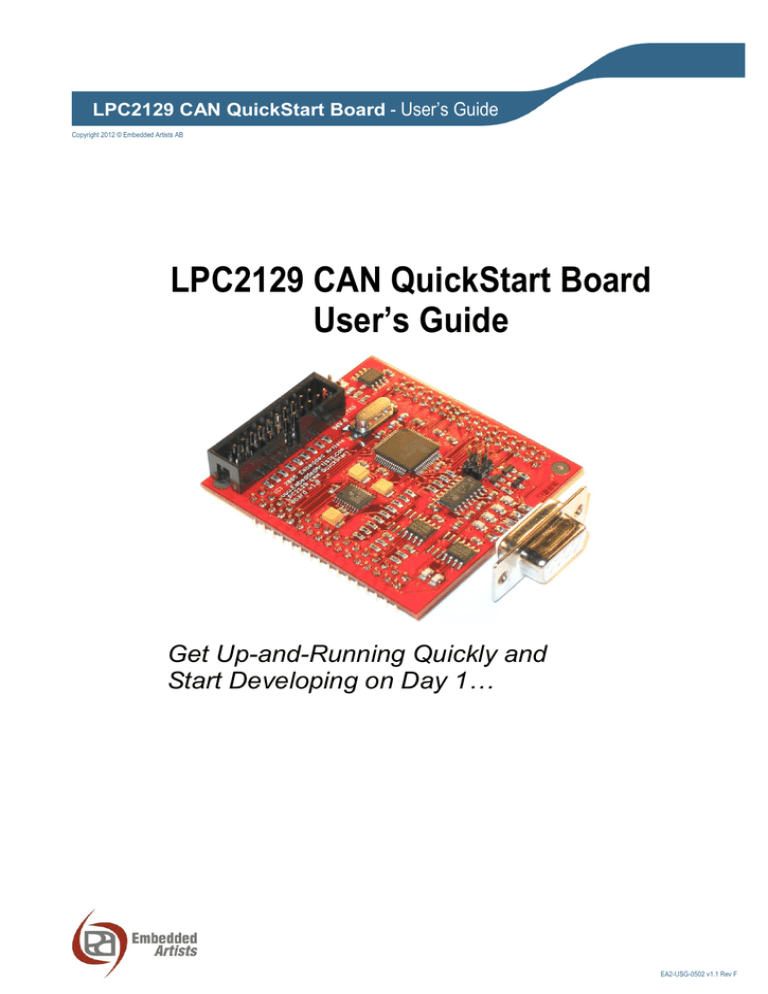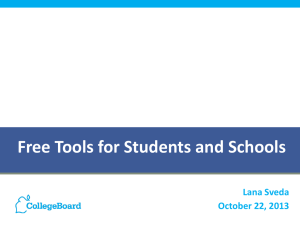
LPC2129 CAN QuickStart Board - User’s Guide
Copyright 2012 © Embedded Artists AB
LPC2129 CAN QuickStart Board
User’s Guide
Get Up-and-Running Quickly and
Start Developing on Day 1…
EA2-USG-0502 v1.1 Rev F
LPC2129 CAN QuickStart Board - User’s Guide
Page 2
Embedded Artists AB
Davidshallsgatan 16
SE-211 45 Malmö
Sweden
info@EmbeddedArtists.com
http://www.EmbeddedArtists.com
Copyright 2005-2012 © Embedded Artists AB. All rights reserved.
No part of this publication may be reproduced, transmitted, transcribed, stored in a retrieval system, or
translated into any language or computer language, in any form or by any means, electronic,
mechanical, magnetic, optical, chemical, manual or otherwise, without the prior written permission of
Embedded Artists AB.
Disclaimer
Embedded Artists AB makes no representation or warranties with respect to the contents hereof and
specifically disclaims any implied warranties or merchantability or fitness for any particular purpose.
Information in this publication is subject to change without notice and does not represent a
commitment on the part of Embedded Artists AB.
Feedback
We appreciate any feedback you may have for improvements on this document. Please send your
comments to support@EmbeddedArtists.com.
Trademarks
All brand and product names mentioned herein are trademarks, services marks, registered
trademarks, or registered service marks of their respective owners and should be treated as such.
Copyright 2012 © Embedded Artists AB
LPC2129 CAN QuickStart Board - User’s Guide
Page 3
Table of Contents
1 Document Revision History
4
2 Introduction
5
2.1
Contents
5
2.2
Features
5
2.3
ESD Precaution
6
2.4
CE Assessment
6
2.5
Other Products from Embedded Artists
6
2.5.1
Design and Production Services
6
2.5.2
OEM / Education / QuickStart Boards and Kits
7
3 Board Design
8
3.1
Board Schematics
8
3.2
Mechanical Dimensions
9
4 Getting Started
4.1
Test program
10
4.2
Program Development
10
5 Further Information
Copyright 2012 © Embedded Artists AB
10
11
LPC2129 CAN QuickStart Board - User’s Guide
Page 4
1 Document Revision History
Revision
Date
Description
v1.1 rev F
2012-01-13
Added this revision history table. Added note about ESD precaution
and CE marking. Removed schematic from document.
Copyright 2012 © Embedded Artists AB
LPC2129 CAN QuickStart Board - User’s Guide
Page 5
2 Introduction
Thank you for buying Embedded Artists’ LPC2129 CAN QuickStart Board based on NXP’s ARM7TDMI
LPC2129 microcontroller.
This document is a User’s Guide that describes the LPC2129 CAN QuickStart Board design along with
the accompanying software and program development tools. The document contains information on
how to use and integrate the board in your own designs, including electrical and mechanical
information.
2.1
Contents
The box received when ordering the LPC2129 CAN QuickStart Board contains the following:
The LPC2129 CAN QuickStart Board.
In addition, the following is needed in order to start developing applications with the LPC2129 CAN
QuickStart Board:
A DC power supply, 5 volt, capable of providing at least 150 mA (more if external circuits
need power from the 3.3 volt supply). Note that the LPC2129 CAN QuickStart Board does not
contain any reverse polarity protection. If voltage is applied with wrong polarity, the board will
likely be damaged. Also note that 6.0 volt is the absolute maximum voltage that can be
applied without damaging the on-board voltage regulator (TPS70251) and the CAN
transceivers (TAJ104x). Consult the TPS70251 datasheet for exact details.
A serial extension cable, DB9-male to DB9-female (DB9M-DM9F), for connecting the
LPC2129 CAN QuickStart Board to a PC.
An optional JTAG interface, for program development debugging.
2.2
Features
Embedded Artists’ LPC2129 CAN QuickStart Board lets you get up-and-running quickly with NXP’s
ARM7TDMI LPC2129 microcontroller. The small form factor board offers many unique features that
ease your development.
NXP’s ARM7TDMI LPC2129 microcontroller with 256 Kbyte program Flash, 16 Kbyte SRAM,
and 2 CAN communication channels.
Note that LPC2194 can possibly be mounted on the board. This version is compatible with
LPC2129 but have 2 additional CAN channels on the chip.
All LPC2129 I/O pins are available on connectors
12.0000 MHz crystal for maximum execution speed and standard CAN bit rates
Phase-locked loop (PLL) multiplies frequency with five; 5 x 12.0000 MHz = 60.0000 MHz
Dual CAN channels with TJA1040 transceivers
ESD/EMI protected RS232 channel with DSUB-9 connector
256 Kbit I2C E2PROM
Onboard low-dropout voltage and reset generation.
Copyright 2012 © Embedded Artists AB
Generates +3.3V and +1.8V from a single +5V supply
+3.3V available for external circuits, up to 300 mA
Power supply: 5 VDC, at least 150 mA
Simple and automatic program download (ISP) via RS232 channel
LPC2129 CAN QuickStart Board - User’s Guide
Circuit that automatically controls the boot loader from RS232 channel
Easy to connect to JTAG signals
Dimensions: 55 x 58 mm
2.3
Page 6
Four layer PCB (FR-4 material) for best noise immunity
ESD Precaution
Please note that the LPC2129 CAN QuickStart Board come without any
case/box and all components are exposed for finger touches – and therefore
extra attention must be paid to ESD (electrostatic discharge) precaution.
Make it a habit always to first touch the ground pin on the expansion pin
list for a few seconds with both hands before touching any other parts of
the board. That way, you will have the same potential as the board and
therefore minimize the risk for ESD.
Note that Embedded Artists does not replace boards that have been damaged by ESD.
2.4
CE Assessment
The LPC2129 CAN QuickStart Board is CE marked. See separate CE Declaration of Conformity
document.
The LPC2129 CAN QuickStart Board is a class B product.
EMC emission test has been performed on the LPC2129 CAN QuickStart Board. General expansion
connectors where internal signals are made available have been left unconnected. Connecting other
devices to the product via the general expansion connectors may alter EMC emission. It is the user’s
responsibility to make sure EMC emission limits are not exceeded when connecting other devices to
the general expansion connectors of the LPC2129 CAN QuickStart Board.
Due to the nature of the LPC2129 CAN QuickStart Board – an evaluation board not for integration into
an end-product – fast transient immunity tests and conducted radio-frequency immunity tests have not
been executed. Externally connected cables are assumed to be less than 3 meters. The general
expansion connectors where internal signals are made available do not have any other ESD protection
than from the chip themselves. Observe ESD precaution.
Note that the LPC2129 CAN QuickStart Board can also be considered to be a component if integrated
into another product. The CE mark on the LPC2129 CAN QuickStart Board cannot be extended to
include the new (user created) product. It is the user’s responsibility to make sure EMC emission limits
are not exceeded and CE mark the final product.
2.5
Other Products from Embedded Artists
Embedded Artists have a broad range of LPC1000/2000/3000/4000 based boards that are very low
cost and developed for prototyping / development as well as for OEM applications. Modifications for
OEM applications can be done easily, even for modest production volumes. Contact Embedded Artists
for further information about design and production services.
2.5.1
Design and Production Services
Embedded Artists provide design services for custom designs, either completely new or modification to
existing boards. Specific peripherals and I/O can be added easily to different designs, for example,
communication interfaces, specific analog or digital I/O, and power supplies. Embedded Artists has a
broad, and long, experience in designing industrial electronics in general and with NXP’s
LPC1000/2000/3000/4000 microcontroller families in specific. Our competence also includes wireless
and wired communication for embedded systems. For example IEEE802.11b/g (WLAN), Bluetooth™,
ZigBee™, ISM RF, Ethernet, CAN, RS485, and Fieldbuses.
Copyright 2012 © Embedded Artists AB
LPC2129 CAN QuickStart Board - User’s Guide
2.5.2
Page 7
OEM / Education / QuickStart Boards and Kits
Visit Embedded Artists’ home page, www.EmbeddedArtists.com, for information about other OEM /
Education / QuickStart boards / kits or contact your local distributor.
Copyright 2012 © Embedded Artists AB
LPC2129 CAN QuickStart Board - User’s Guide
Page 8
3 Board Design
This chapter contains detailed information about the electrical and mechanical design of the LPC2129
CAN QuickStart Board. The schematic can be downloaded in pdf format from the support page, and is
recommended to have printed out while reading this chapter. A number of example circuits are also
presented that will lower the threshold of start developing with the board.
3.1
Board Schematics
Besides the LPC2129 microcontroller from NXP, the board contains dual CAN transceivers, a dual
voltage regulator with an internal reset generator, a 256 Kbit I2C E2PROM, and an ESD/EMI protected
RS232 serial channel. A red LED is connected to the reset signal and lights when reset is active, i.e.,
the signal is low.
The microcontroller crystal frequency is 12.0000 MHz. This frequency has been selected in order to
allow close to maximum execution speed (5 x 12.0000 MHz = 60.0000 MHz, which is the maximum
frequency) as well as to provide standard CAN communication bit rates. The crystal frequency can be
changed to any desired value for OEM orders, provided that the conditions in the LPC2129 datasheet
are met. Current requirements are (but consult the most current datasheet for latest details):
1-30 MHz if the on-chip phase-locked loop (PLL) is not used, or
10-25 MHz if the PLL is to be used.
The design has direct and automatic support for program downloading (via ISP) over the RS232 serial
channel. The RS232 signal DTR controls the reset signal to the LPC2129 microcontroller. The RS232
signal RTS is connected to pin P0.14 in the LPC2129 microcontroller. This pin is sampled after reset
and determines if the internal bootloader program shall be started, or not. A low signal after reset
enters the bootloader mode. Both the RS232 receive and transmit signals as well as the RTS/DTR
signals can be disconnected from the microcontroller via four links / jumpers on the board. See Figure
1 below for details.
J8, JTAG enable
In order from left to right:
J6 (P0.14), J7 (Reset)
Figure 1 - LPC2129 CAN QuickStart Board Jumpers
Copyright 2012 © Embedded Artists AB
LPC2129 CAN QuickStart Board - User’s Guide
3.2
Page 9
Mechanical Dimensions
The board interface connectors are placed in two 2x16 pin rows along the board edges. They are 1800
mil apart (measured from outer edges). Figure 2 below contains a drawing of the board that includes
mechanical measures.
J3, pin1
P1.16
58.1 mm,
2290 mil
J2, pin1
P0.0
8.1 mm,
320 mil
about 12 mm
2.54 mm,
100 mil
2.54 mm, 100 mil
45.7 mm, 1800 mil
55.2 mm, 2170 mil
Figure 2 - LPC2129 CAN QuickStart Board Mechanical Dimensions
Copyright 2012 © Embedded Artists AB
LPC2129 CAN QuickStart Board - User’s Guide
Page 10
4 Getting Started
4.1
Test program
The LPC2129 CAN QuickStart Board comes preloaded with a test program. This program can be used
to verify that the board operates correctly.
The test program outputs a running-one to port pins P0.4 – P0.31, meaning that one LED at a time will
light (in a running-one pattern). Pins P0.0 – P0.1 are tested via the serial channel and pins P0.2 – P0.3
are tested via the I2C bus. The two CAN channels can be connected together to test the CAN
channels. Also, a terminal program should be attached to the RS232 DSUB-9 connector. The test
program will output test information regarding the I2C E2PROM test, and CAN test. Also, the
UART/RS232 channel can be tested by typing characters in the terminal program.
The settings for the terminal program are: 38.4 kbps, 8 data bits, no parity bits, and one stop bit (i.e.,
8N1).
The output from the test program will look something like in Figure 3 below.
Figure 3 – Example Test Program Output
4.2
Program Development
Consult the QuickStart Program Development User’s Manual for more information about the
QuickStart Build Environment from Embedded Artists, and program development for the ARM7 in
general.
Copyright 2012 © Embedded Artists AB
LPC2129 CAN QuickStart Board - User’s Guide
Page 11
5 Further Information
The LPC2129 microcontroller is a complex circuit and there exist a number of other documents with a
lot more information. The following documents are recommended as a complement to this document.
[1] NXP LPC2129 Datasheet
http://ics.nxp.com/products/lpc2000/pdf/lpc2119.lpc2129.pdf
[2] NXP LPC2129 User’s Manual
http://ics.nxp.com/support/documents/microcontrollers/pdf/
user.manual.lpc2119.lpc2129.lpc2194.lpc2292.lpc2294.pdf
[3] NXP LPC2129 Errata Sheet
http://ics.nxp.com/support/documents/microcontrollers/pdf/errata.lpc2129.pdf
[4] ARM7TDMI Technical Reference Manual. Document identity: DDI0029G
http://www.arm.com/pdfs/DDI0029G_7TDMI_R3_trm.pdf
[5] ARM Architecture Reference Manual. Document identity: DDI0100E
Book, Second Edition, edited by David Seal, Addison-Wesley: ISBN 0-201-73719-1
Also available in PDF form on the ARM Technical Publications CD
[6] ARM System Developer’s Guide – Designing and Optimizing System Software, by A.N. Sloss,
D Symes, C. Wright. Elsevier: ISBN 1-55860-874-5
[7] Embedded System Design on a Shoestring, by Lewin Edwards.
Newnes: ISBN 0750676094.
[8] GNU Manuals
http://www.gnu.org/manual/
[9] GNU ARM tool chain for Cygwin
http://www.gnuarm.com
[10] An Introduction to the GNU Compiler and Linker, by Bill Gatliff
http://www.billgatliff.com
[11] LPC2000 Yahoo Group. A discussion forum dedicated entirely to the NXP’s LPC2xxx series of
microcontrollers.
http://groups.yahoo.com/group/lpc2000/
[12] The Insider’s Guide to the NXP’s ARM7-Based Microcontrollers, by Trevor Martin.
http://www.hitex.co.uk/arm/lpc2000book/index.html
Also note that there can be newer versions of the documents than the ones linked to here. Always
check for the latest information / version.
Copyright 2012 © Embedded Artists AB



